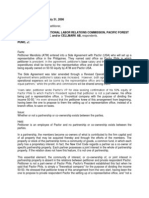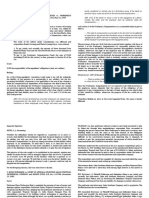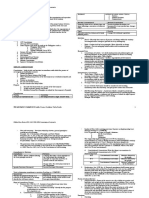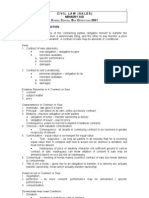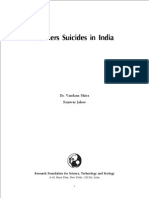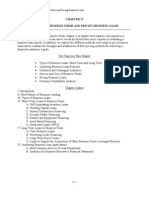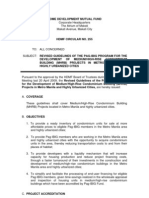Santos Vs Spouses Reyes Digest
Santos Vs Spouses Reyes Digest
Uploaded by
Diannee RomanoCopyright:
Available Formats
Santos Vs Spouses Reyes Digest
Santos Vs Spouses Reyes Digest
Uploaded by
Diannee RomanoOriginal Description:
Original Title
Copyright
Available Formats
Share this document
Did you find this document useful?
Is this content inappropriate?
Copyright:
Available Formats
Santos Vs Spouses Reyes Digest
Santos Vs Spouses Reyes Digest
Uploaded by
Diannee RomanoCopyright:
Available Formats
TITLE OF THE CASE: FERNANDO SANTOS, petitioner vs. Spouses ARSENIO and NIEVES REYES, respondents.
GR NO: 135813 DATE: October 25, 2001 PONENTE
FACTS: In June 1986, Fernando Santos and Nieves Reyes were introduced to each other by Meliton Zabat regarding a lending business venture proposed by Nieves. Fernando Santos (70%), Nieves Reyes (15%), and Melton Zabat (15%) orally instituted a partnership with them as partners. It was agreed that Santos shall be financier and that Nieves and Zabat shall contribute their industry by taking charge of solicitation of members and collection of loan payments. Their venture was launched on June 13, 1986, with the agreement that Santos would receive 70% of the profits while Nieves and Zabat would earn 15% each.
Later, in July 1986, Nieves introduced Cesar Gragera to Santos. Gragera was the chairman of Monte Maria Development Corporation. Gragera sought short-term loans for members of the corporation. It was agreed that the partnership shall provide loans to the employees of Grageras corporation and Gragera shall earn commission from loan payments.
In August 1986, the three partners put into writing their verbal agreement to form the partnership. As earlier agreed, Santos shall finance and Nieves shall do the daily cash flow more particularly from their dealings with Gragera, Zabat on the other hand shall be a loan investigator. But then later, Nieves and Santos found out that Zabat was engaged in another lending business which competes with their partnership hence Zabat was expelled.
The two continued with the partnership and they took with them Nieves husband, Arsenio, who became their loan investigator. Later, Santos accused the spouses of not remitting Grageras commissions to the latter. He sued them for collection of sum of money. The spouses countered that Santos merely filed the complaint because he did not want the spouses to get their shares in the profits. Santos argued that the spouses, insofar as the dealing with Gragera is concerned, are merely his employees. Santos alleged that there is a distinct partnership between him and Gragera which is separate from the partnership formed between him, Zabat and Nieves.
PLAINTIFFS ARGUMENTS: Petitioner maintains that he employed the services of respondent spouses in the money-lending venture with Gragera, with Nieves as bookkeeper and Arsenio as credit investigator. That Nieves introduced Gragera to Santos did not make her a partner. She was only a witness to the Agreement between the two. Separate from the partnership between petitioner and Gragera was that which existed among petitioner, Nieves and Zabat, a partnership that was dissolved when Zabat was expelled. DEFENDANTS ARGUMENTS: In their answer, the defendants asserted that they were partners and not mere employees of petitioner. The complaint, they alleged, was filed to preempt and prevent them from claiming their rightful share to the profits of the partnership. Arsenio alleged that he was enticed by the petitioner to take the place of Zabat after petitioner learned of Zabat's activities. Arsenio resigned from his job at the Asian Development Bank to join the partnership. Nieves claimed that she participated in the business as a partner, as the lending activity with Monte Maria originated from her initiative. DECISIONS OF - LOWER COURT: The Trial court held that respondents were partners, and not merely employees of the petitioner. It ruled that Gragera was only a commission agent of petitioner, not his partner. CA: The CA upheld the decision of the lower court. The CA ruled that the following circumstances indicated the existence of a partnership among the parties (1) it was Nieves who broached to petitioner the idea of starting a money-lending business and introduced him to Gragera (2) Arsenio received dividends or profit-shares covering the period of July 15 to August 7, 1986 (3) the partnership contract was executed after the Agreement with Gragera and petitioner and thus showed the parties intention to consider it as a transaction of the partnership. In their common venture, petitioner invested capital while respondents contributed industry or services with the intention of sharing in the profits of the business. The defendants were industrial partners of the petitioner. Nieves herself provided the initiative in the lending activities with Monte Maria. In consonance with the agreement between appellant, Nieves and Zabat (later replaced by Arsenio), they contributed industry to the common fund with the intention of sharing in the profits of the partnership. The spouses provided services without which the partnership would not have [had] the wherewithal to carry on the purpose for which it was organized and as such [were] considered industrial partners the partnership between Santos, Nieves and Zabat was technically dissolved by the expulsion of Zabat therefrom, the remaining partners simply continued the business of the partnership without undergoing the procedure relative to dissolution. Instead, they invited Arsenio to participate as a partner in their operations. There was therefore,
no intent to dissolve the earlier partnership. The partnership between Santos, Nieves and Arsenio simply took over and continued the business of the former partnership with Zabat, one of the incidents of which was the lending operations with Monte Maria. Gragera and Santos were not partners. The money-lending activities undertaken with Monte Maria was done in pursuit of the business for which the partnership between [petitioner], Nieves and Zabat (later Arsenio) was organized. Gragera who represented Monte Maria was merely paid commissions in exchange for the collection of loans. The commissions were fixed on gross returns, regardless of the expenses incurred in the operation of the business. The sharing of gross returns does not in itself establish a partnership.
ISSUE/S: Whether or not the Santos and Spouses Reyes are partners Whether or not the Spouses Reyes has a share in the partnership profits being Industrial partners.
HELD: FIRST ISSUE: BUSINESS RELATIONSHIP Yes, the court upheld the decisions of the Trial Court and CA that there was a partnership created between Santos and Spouses Reyes. By the contract of partnership, two or more persons bind themselves to contribute money, property or industry to a common fund, with the intention of dividing the profits among themselves. The "Articles of Agreement" stipulated that the signatories shall share the profits of the business in a 70-15-15 manner, with petitioner getting the lion's share. This stipulation clearly proved the establishment of a partnership.
Though it is true that the original partnership between Zabat, Santos and Nieves was terminated when Zabat was expelled, the said partnership was however considered continued when Nieves and Santos continued engaging as usual in the lending business even getting Nieves husband, who resigned from the Asian Development Bank, to be their loan investigator who, in effect, substituted Zabat. There is no separate partnership between Santos and Gragera. The latter being merely a commission agent of the partnership. This is even though the partnership was formalized shortly after Gragera met with Santos.
SECOND ISSUE: ACCOUNTING OF PARTNERSHIP HOWEVER, the order of the Court of Appeals directing Santos to give the spouses their shares in the profit is premature. The accounting made by the trial court is based on the total income of the partnership. Such total income calculated by the trial court did not consider the expenses sustained by the partnership. All expenses incurred by the money-lending enterprise of the parties must first be deducted from the total income in order to arrive at the net profit of the partnership. The share of each one of them should be based on this net profit and not from the gross income or total income. For the purpose of determining the profit that should go to an industrial partner (who shares in the profits but is not liable for the losses), the gross income from all the transactions carried on by the firm must be added together, and from this sum must be subtracted the expenses or the losses sustained in the business. Only in the difference representing the net profits does the industrial partner share. But if, on the contrary, the losses exceed the income, the industrial partner does not share in the losses.
You might also like
- Form 5 Accounting: Transaction Analysis ExerciseDocument33 pagesForm 5 Accounting: Transaction Analysis ExerciseCahyani Prastuti100% (1)
- Title G.R. NO. G.R. No. 135813 Date of Promulgation Ponente FactsDocument3 pagesTitle G.R. NO. G.R. No. 135813 Date of Promulgation Ponente FactsRhett Vincent De La rosaNo ratings yet
- Negado Vs Makabenta DigestDocument1 pageNegado Vs Makabenta DigestOwen Buenaventura100% (1)
- Tuason vs. Bolanos Case DigestDocument1 pageTuason vs. Bolanos Case DigestGracelyn Enriquez Bellingan100% (2)
- SANTOS vs. SPS. REYESDocument2 pagesSANTOS vs. SPS. REYESAnn CatalanNo ratings yet
- Santos vs. Reyes (Case Digest)Document1 pageSantos vs. Reyes (Case Digest)Rikki BanggatNo ratings yet
- Fernando Santos Vs Spouses ReyesDocument2 pagesFernando Santos Vs Spouses ReyesCindy Ann SilvaNo ratings yet
- 1) Red Line Trans. vs. Rural Transit, 60 Phil. 549Document2 pages1) Red Line Trans. vs. Rural Transit, 60 Phil. 549Talia YapNo ratings yet
- TOCAO Vs CADocument3 pagesTOCAO Vs CAJane Sudario100% (3)
- Mendiola vs. CA G.R. 159333 July 31, 2006Document2 pagesMendiola vs. CA G.R. 159333 July 31, 2006Elle75% (4)
- Woodhouse Vs Halili, 93 Phil 526 (1953)Document1 pageWoodhouse Vs Halili, 93 Phil 526 (1953)Lu CasNo ratings yet
- HEIRS OF TAN ENG KEE Vs CADocument2 pagesHEIRS OF TAN ENG KEE Vs CAJelaine AñidesNo ratings yet
- Ortega vs. Court of Appeals, 245 SCRA 529 5. Estanislao, Jr. vs. Court of Appeals, 160 SCRA 830Document8 pagesOrtega vs. Court of Appeals, 245 SCRA 529 5. Estanislao, Jr. vs. Court of Appeals, 160 SCRA 830Veepee PanzoNo ratings yet
- Fue Leung vs. IAC, 169 SCRA 746Document2 pagesFue Leung vs. IAC, 169 SCRA 746ylourah100% (1)
- Heirs of Tan Eng Kee Vs CADocument1 pageHeirs of Tan Eng Kee Vs CAAliceNo ratings yet
- Partnersip Case DigestsDocument29 pagesPartnersip Case DigestsAMBNo ratings yet
- Digest Ortega Vs CADocument2 pagesDigest Ortega Vs CAOwen Buenaventura50% (2)
- Case Digest PartnershipDocument3 pagesCase Digest Partnershiplamadridrafael100% (1)
- Josefina Realubit Vs ProsencioDocument4 pagesJosefina Realubit Vs ProsencioMarvin A Gamboa100% (2)
- LIM TONG LIM, vs. PHILIPPINE FISHING GEAR INDUSTRIES, INC.Document9 pagesLIM TONG LIM, vs. PHILIPPINE FISHING GEAR INDUSTRIES, INC.Regine FayeDongui-is Munda CruzNo ratings yet
- PAT Digests-1st SetDocument37 pagesPAT Digests-1st SetACAJ100% (2)
- National Coal Company Vs CIRDocument1 pageNational Coal Company Vs CIRJayson CamasuraNo ratings yet
- Saludo Vs PNB Case DigestDocument3 pagesSaludo Vs PNB Case DigestNovi Mari Noble0% (1)
- Cases (Corporation) PDFDocument20 pagesCases (Corporation) PDFJay-ar VillanuevaNo ratings yet
- Partnership Digested CasesDocument7 pagesPartnership Digested CasesJoan Christine100% (1)
- CASE #9 Ang Pue & Co v. Sec of Commerce and IndustryDocument1 pageCASE #9 Ang Pue & Co v. Sec of Commerce and Industryjulandmic9No ratings yet
- Aniceto Saludo, Jr. vs. PNBDocument1 pageAniceto Saludo, Jr. vs. PNBValora France Miral AranasNo ratings yet
- 1 - Mendiola v. CA DIGESTDocument3 pages1 - Mendiola v. CA DIGEST2ESBU COL1819No ratings yet
- Partnership (Case Digests)Document17 pagesPartnership (Case Digests)Lou Ann AncaoNo ratings yet
- Navarro vs. CA Et. Al, May 27, 1993, G.R. No. 101847 - DigestDocument2 pagesNavarro vs. CA Et. Al, May 27, 1993, G.R. No. 101847 - DigestMichelle LimNo ratings yet
- 17 Heirs of Tan Eng Kee V CADocument2 pages17 Heirs of Tan Eng Kee V CANichole LanuzaNo ratings yet
- Yulo vs. SengDocument3 pagesYulo vs. Sengvaleryanns100% (1)
- SY vs. CADocument1 pageSY vs. CAAlleine TupazNo ratings yet
- Island Sales v. United PioneersDocument2 pagesIsland Sales v. United Pioneerslucky javellana100% (1)
- Case DigestsDocument2 pagesCase DigestsKenneth Christian WilburNo ratings yet
- Case Citation: Date: Petitioners: Respondents: DoctrineDocument6 pagesCase Citation: Date: Petitioners: Respondents: DoctrineCarie LawyerrNo ratings yet
- Tocao Vs CADocument1 pageTocao Vs CAJustin Loredo50% (2)
- Development Bank of The Philippines, Petitioner, vs. Commission On AUDIT, RespondentDocument15 pagesDevelopment Bank of The Philippines, Petitioner, vs. Commission On AUDIT, RespondentMaritoni RoxasNo ratings yet
- Mendiola Vs Court of Appeals (497 SCRA 346)Document2 pagesMendiola Vs Court of Appeals (497 SCRA 346)Kathrine Marie AbquinaNo ratings yet
- Case No 5 Cuaycong VS CuaycongDocument2 pagesCase No 5 Cuaycong VS CuaycongJaphet C. VillaruelNo ratings yet
- Jarantilla Vs JarantillaDocument2 pagesJarantilla Vs JarantillaJelaine AñidesNo ratings yet
- Outline Agency - Filled OutDocument9 pagesOutline Agency - Filled OutZahraMinaNo ratings yet
- Tai Tong Chuache V Insurance CommissionDocument1 pageTai Tong Chuache V Insurance CommissionWILLAMNo ratings yet
- 13) Nielson & Company Inc V LepantoDocument1 page13) Nielson & Company Inc V LepantoweewoouwuNo ratings yet
- Arias - Atp DigestsDocument5 pagesArias - Atp DigestsPolaNo ratings yet
- Law On PartnershipDocument6 pagesLaw On PartnershipGLORILYN MONTEJONo ratings yet
- Transpo Part 2 PDFDocument78 pagesTranspo Part 2 PDFAlyssa Abigael GomezNo ratings yet
- Angeles V Secretary of JusticeDocument6 pagesAngeles V Secretary of JusticeHudson CeeNo ratings yet
- Evangelista & Co. Et - Al. v. Estrella Abad Santos Digest 2Document2 pagesEvangelista & Co. Et - Al. v. Estrella Abad Santos Digest 2mastaaca100% (2)
- ALDECOA & CO. vs. WARNER BARNES & CO. 16 PHIL 423 - DigestDocument2 pagesALDECOA & CO. vs. WARNER BARNES & CO. 16 PHIL 423 - DigestMichelle LimNo ratings yet
- Tuason Vs BolañosDocument1 pageTuason Vs BolañosLawdemhar CabatosNo ratings yet
- Aurbach Vs Sanitary Wares DigestDocument1 pageAurbach Vs Sanitary Wares DigestIvy Paz100% (8)
- FactsDocument1 pageFactsweewoouwuNo ratings yet
- Case Citation: G.R. No. L-10918 Date: Petitioners: Respondents: Doctrine: Antecedent FactsDocument1 pageCase Citation: G.R. No. L-10918 Date: Petitioners: Respondents: Doctrine: Antecedent FactsCarie LawyerrNo ratings yet
- Ortega vs. CADocument2 pagesOrtega vs. CAKristine Hipolito SerranoNo ratings yet
- Digest - Heirs of Tan Eng Kee vs. CADocument1 pageDigest - Heirs of Tan Eng Kee vs. CAPaul Vincent Cunanan100% (2)
- Mendiola Vs CA DigestDocument2 pagesMendiola Vs CA DigestHEROPROVIDO100% (2)
- BusOrg Case Digest 9-18Document11 pagesBusOrg Case Digest 9-18ErickvannNo ratings yet
- Case DigestDocument4 pagesCase DigestTanya PimentelNo ratings yet
- REYES, RespondentsDocument6 pagesREYES, RespondentsPat EspinozaNo ratings yet
- Santos V Spouses ReyesDocument3 pagesSantos V Spouses ReyesMis DeeNo ratings yet
- Counter-Affidavit EditedDocument2 pagesCounter-Affidavit EditedDiannee RomanoNo ratings yet
- REMEDIAL - Metropolitan Bank and Trust Co Vs Tobias - Principle of Non-Interference in The Determination of The Existence of Probable CauseDocument14 pagesREMEDIAL - Metropolitan Bank and Trust Co Vs Tobias - Principle of Non-Interference in The Determination of The Existence of Probable CauseDiannee RomanoNo ratings yet
- Corporation Law (Updated As of Nov 2013)Document8 pagesCorporation Law (Updated As of Nov 2013)Justin CebrianNo ratings yet
- REMEDIAL - Galvez Vs CA - Mere Failure To Attach Copies of Pleadings Not Enough To Dismiss A CaseDocument12 pagesREMEDIAL - Galvez Vs CA - Mere Failure To Attach Copies of Pleadings Not Enough To Dismiss A CaseDiannee RomanoNo ratings yet
- Nachura and Case Doctrines (Midterms)Document61 pagesNachura and Case Doctrines (Midterms)Diannee RomanoNo ratings yet
- Rivera Vs AngelesDocument1 pageRivera Vs AngelesDiannee Romano100% (2)
- Republic of The Philippines V Cipriano Orbecido Iii GR NO. 154380 October 5, 2005Document1 pageRepublic of The Philippines V Cipriano Orbecido Iii GR NO. 154380 October 5, 2005Diannee RomanoNo ratings yet
- Crim Rev Book 2-Atty - GarciaDocument177 pagesCrim Rev Book 2-Atty - GarciaDiannee Romano100% (1)
- Article 36 Psychological Incapacity Republic of The Philippines vs. Court of Appeals G.R. No. 108763 February 13, 1997 FactsDocument1 pageArticle 36 Psychological Incapacity Republic of The Philippines vs. Court of Appeals G.R. No. 108763 February 13, 1997 FactsDiannee RomanoNo ratings yet
- Manotok Vs Barque - Complete DigestDocument7 pagesManotok Vs Barque - Complete DigestDiannee RomanoNo ratings yet
- TCT TagaytayDocument2 pagesTCT TagaytayDiannee RomanoNo ratings yet
- A.M. No. 12-8-8-SCDocument4 pagesA.M. No. 12-8-8-SCDiannee RomanoNo ratings yet
- Herminia Voluntad Ramirez Vs Atty. BautistaDocument3 pagesHerminia Voluntad Ramirez Vs Atty. BautistaDiannee RomanoNo ratings yet
- Manotok Vs Barque - Complete DigestDocument7 pagesManotok Vs Barque - Complete DigestDiannee RomanoNo ratings yet
- Pagcor vs. CarandangDocument2 pagesPagcor vs. CarandangDiannee RomanoNo ratings yet
- Supreme Court: Tañada, Sanchez, Tañada, Tañada For Petitioner. N.M. Lapuz For RespondentDocument10 pagesSupreme Court: Tañada, Sanchez, Tañada, Tañada For Petitioner. N.M. Lapuz For RespondentDiannee RomanoNo ratings yet
- Agrarian Law - Case DigestsDocument22 pagesAgrarian Law - Case DigestsDiannee RomanoNo ratings yet
- Sales Digest-Dizon Vs DizonDocument10 pagesSales Digest-Dizon Vs Dizoncathy1808No ratings yet
- Sales NotesDocument69 pagesSales NotesArlan CruzNo ratings yet
- De Leon Vs Ong PDFDocument1 pageDe Leon Vs Ong PDFDiannee RomanoNo ratings yet
- Civil Law (Sales) Memory Aid A C B O 2001: Chapter 1: IntroductionDocument29 pagesCivil Law (Sales) Memory Aid A C B O 2001: Chapter 1: IntroductionAñepedlav Sednoc EnelraNo ratings yet
- A Conversation About Upgrading at Bang BuaDocument10 pagesA Conversation About Upgrading at Bang BuaNeha SinglaNo ratings yet
- Farmers Suicides in India: Dr. Vandana Shiva Kunwar JaleesDocument54 pagesFarmers Suicides in India: Dr. Vandana Shiva Kunwar JaleesTanya RawalNo ratings yet
- 5 - Manuel C. Manarang and Lucia D. Manarang, Petitioners-Appellants, vs. Macario M. OfiladaDocument4 pages5 - Manuel C. Manarang and Lucia D. Manarang, Petitioners-Appellants, vs. Macario M. Ofiladadondz100% (1)
- Smeda HyderabadDocument141 pagesSmeda HyderabadNOOR AHMEDNo ratings yet
- Business and The Social EnvironmentDocument19 pagesBusiness and The Social EnvironmentPiran UmrigarNo ratings yet
- Pameco V CaDocument2 pagesPameco V Cajodelle11No ratings yet
- Microfinance PDFDocument170 pagesMicrofinance PDFADDA247 JAIIB Mentor0% (1)
- 14 NPC MD106Document89 pages14 NPC MD106Yagya0% (1)
- Vieux Fort Water Supply Redevelopment Project - Saint LuciaDocument2 pagesVieux Fort Water Supply Redevelopment Project - Saint Lucialifemillion2847No ratings yet
- Chap 017Document20 pagesChap 017محمود علىNo ratings yet
- ACT 540 Ghana Highway Authority Act, 1997Document16 pagesACT 540 Ghana Highway Authority Act, 1997Thomas KutinNo ratings yet
- Credit Utilization and Repayment Performance of Members ofDocument122 pagesCredit Utilization and Repayment Performance of Members ofendeshaw yibetalNo ratings yet
- Functions of Development BanksDocument26 pagesFunctions of Development Bankskunkumabala50% (2)
- HDMF Circular 255Document7 pagesHDMF Circular 255Jay O CalubayanNo ratings yet
- FCT V Phillips 73 ATC 4,361: (Pacific Acceptance Corp LTD V Forsyth (No 2) ) Caused The Partners of The Firm To ConsiderDocument4 pagesFCT V Phillips 73 ATC 4,361: (Pacific Acceptance Corp LTD V Forsyth (No 2) ) Caused The Partners of The Firm To ConsiderPriashna ChandNo ratings yet
- Complete Economics DictionaryDocument13 pagesComplete Economics DictionaryUsman Shaukat - 70642/TCHR/BGJTNo ratings yet
- Bank Statement 2Document12 pagesBank Statement 2bcpjbm6xyxNo ratings yet
- Project TcsDocument12 pagesProject TcsVaibhav DubeyNo ratings yet
- Nanayakkara v. Hatton National Bank PLC (2017) BLR 95Document12 pagesNanayakkara v. Hatton National Bank PLC (2017) BLR 95nuwayasith8No ratings yet
- Chapter 6 Entrepreneurship by Zubair A Khan.Document21 pagesChapter 6 Entrepreneurship by Zubair A Khan.Zubair A Khan100% (4)
- Simple and Compound InterestDocument43 pagesSimple and Compound InterestAnne BergoniaNo ratings yet
- How Can Matching Grants in Agriculture Facilitate Access To Finance Lessons Learned From World Bank Group S Experience PDFDocument68 pagesHow Can Matching Grants in Agriculture Facilitate Access To Finance Lessons Learned From World Bank Group S Experience PDFJack MalambeNo ratings yet
- Civil Law Partition in Partition, The Court Must First Determine The Existence of Co-Ownership. in Partition, The Court Must FirstDocument7 pagesCivil Law Partition in Partition, The Court Must First Determine The Existence of Co-Ownership. in Partition, The Court Must FirstRomNo ratings yet
- Equitable MortgageDocument10 pagesEquitable Mortgagejohnlee rumusudNo ratings yet
- FR Coll GuidelinesDocument23 pagesFR Coll GuidelinesJusta100% (1)
- 1199SEIU United Healthcare East 2021 FinancesDocument241 pages1199SEIU United Healthcare East 2021 FinancesLaborUnionNews.comNo ratings yet
- Repayment ReportDocument4 pagesRepayment ReportBuhly RvsfNo ratings yet
- Seatwork EEco AnnuityDocument17 pagesSeatwork EEco AnnuityJr de GuzmanNo ratings yet
- Waterfall Guidelines DPADocument29 pagesWaterfall Guidelines DPAmarifoviNo ratings yet









